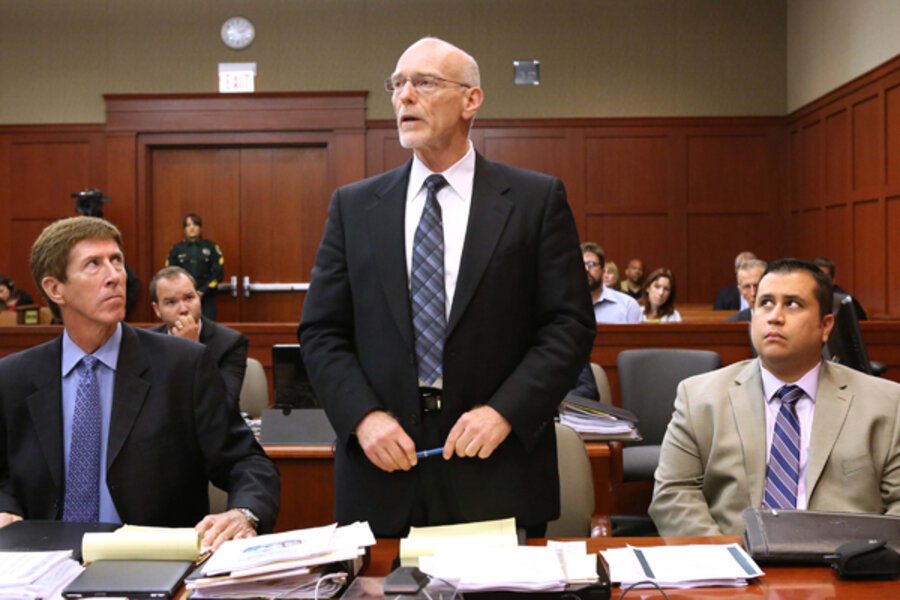Trayvon Martin shooting: Race hangs over case as trial begins
Loading...
The tale of how George Zimmerman shot and killed unarmed black teenager Trayvon Martin on the streets of a gated community in Sanford, Fla., continues to poke at uncomfortable truths in a not-so-post-racial America – including perceptions about profiling, interracial crime fears, drug use stereotypes, and vigilantism.
But the trial of Mr. Zimmerman on second-degree murder charges, which begins Monday, will present jurors with a more straightforward task than addressing the nation's imperfections.
After a year of legal maneuvering by both sides, the basic question jurors will consider remains the same: Was Zimmerman, an aspiring police officer who was part of a volunteer neighborhood watch group, justified in confronting the 17-year-old on a rainy Feb. 26, 2012, and subsequently shooting him point-blank in the chest?
"My expectation is that jurors are actually going to be judging a pretty simple case," says Douglas Keene, a noted jury consultant in Austin, Texas, who has dissected the George Zimmerman case in detail. "Yes, this case touches on a lot of societal concerns more broadly, but the motivation of jurors is not to reconstruct the fabric of society. They just want to answer one question correctly: What actually happened?"
The facts, however, may not be so simple to ascertain, including whether it is Zimmerman or Trayvon, overheard in the background of a 911 call, who was screaming and yelling "stop." Moreover, witness accounts are murky, and some witnesses have changed their original stories about the nature of the fight between the men. A girlfriend who was on the phone with Trayvon turns out to have lied about why she didn't attend Trayvon's funeral.
Zimmerman, too, dug himself a hole by not stopping his wife, Shellie, from lying about the couple's finances at a bond hearing, which got her arrested and him thrown back in jail. And the original explanation for what happened – that Zimmernan invoked his "stand your ground" right under a 2005 Florida law – was sidestepped by defense lawyers when they waived a special self-defense hearing in April.
Prosecutors have one main problem in proving second-degree murder: The key eyewitness is Zimmerman himself, who sustained a broken nose and several cuts to the back of his head during the apparent fight that preceded the shooting. In one hearing, Zimmerman apologized to Trayvon's parents, saying he thought Trayvon was an adult and that he didn't know if the teen was armed or not.
"What the prosecutor should do is … [focus] on all the decisions that Zimmerman made that put him in that situation," says Mr. Keene. "At some point he decided to strap on a gun and pretend he was a police officer … and he conducted himself in a lethal manner … by inviting a provocation through his own behavior."
Zimmerman's defense team has used social media to try to refocus the case onto Trayvon's own character and behavior, in part by publicizing raw social media posts and pictures of Trayvon smoking pot in a bid to counter the "good kid" image put forth by Trayvon's parents and supporters. On the widely publicized 911 tape of George Zimmerman, the defendant describes Trayvon as possibly being under the influence of drugs.
That combination – young black men and drug use – has powerful resonance, social historians say, and could shade a jury's understanding of Zimmerman's actions, even though the judge in the case has said that the Trayvon pictures would likely not be shown to the jury.
"A lot of people who would be making the case that Trayvon Martin was a thug would not identify as racist," says Alex Tepperman, a University of Florida doctoral student whose paper, "Half-Baked: Weed, Race and the Demonization of Trayvon Martin," was presented at a conference in April. "It's sort of an uncomfortable truth, where studies show that all kinds of people in America have immediate visceral sort of nervousness about encountering people of color. It's a very systematic sort of racism that has kind of crept into the American unconscious over time."
The judge's decision to exclude the pot-smoking photos confirms that "this is not about Trayvon Martin's character," says Larry Davis, director of the Center on Race and Social Problems at the University of Pittsburgh. "It's about profiling of African-American males, and the result of what happens when you do that to an unarmed teenager going about his own business."
Moreover, research shows that jurors in racially charged cases usually go out of their way "to play it down the middle," says Keene, the jury consultant.
Yet there's little doubt, given the depth and divide of public reaction to Trayvon's death, that nuances around how Americans perceive one another by their skin color could affect the jury's understanding of Zimmerman's actions.
"It would be awfully hard to prove that George Zimmerman intended to kill Trayvon Martin because he had it out for Trayvon Martin," says Mr. Tepperman. "The more problematic case for George Zimmerman is that all sorts of people who do … feel like there is some sort of racial pecking order in America have lined up to defend him, which unfairly casts him as a racial antagonist, which he very well may not be."






